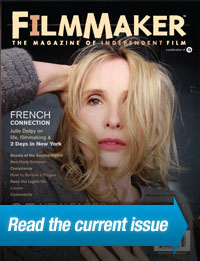STATION TO STATION
Paul Harrill and Chris Cagle meet with Color of a Brisk and Leaping Day's Christopher Münch
The mid-'90s film scene has been a mixed blessing to American independent filmmakers. Certainly, changing markets and increased interest from private equity investors have helped more non-Hollywood filmmakers make and distribute films. Yet, perhaps as a trade-off, more and more independent filmmakers are courting distributors by working in familiar genres, and many of the mini-major distribution companies have begun to emulate Hollywood's blitzkrieg acquisition and promotional strategies. As such practices become commonplace, one wonders what will happen to the less conventional filmmakers who once found a home in the rubric of "independent film."
In particular, the work of Christopher Münch has straddled such contradictions. Münch first gained notoriety for The Hours and Times, a speculative feature about a weekend retreat between John Lennon and Brian Epstein. In addition to being noted as one of the key works of the then-burgeoning New Queer Cinema (along with Todd Haynes' Poison, Tom Kalin's Swoon and the films of Gregg Araki), the film worked against conventions by playing a fictional love story/friendship as historical drama. That the film was shot in a Barcelona hotel room with a single crewperson over the course of a week made its "independence" all the more striking.
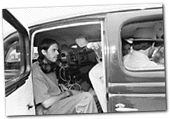 |
| Christopher Münch, photo: Brook Dillon |
Subtitled "a fateful year in the life of John Lee, railroad man," the film chronicles a young man's attempt to save the historic Yosemite Valley Railroad from abandonment at the close of World War II. As he did in Hours, instead of trying to be "faithful" to history (Color is also based on a true incident), Münch downplays the epic and recasts "history" as the ephemeral interactions of daily life.
Filmmaker: Color of a Brisk and Leaping Day tells the story of John Lee, a young man who has a passion for trains - so much so that he tries to save a railroad. I get a sense that you share his passion. When and how did your interest begin?
Münch: My interest in railroads began when I was a kid. But it was a random, emotional thing; I didn't do what rail-fans typically do - collect artifacts. I tried model railroading for a while in my early teens but didn't get very far, since my interest in film developed around the same time. Before I turned ten, while driving through certain sections of my old neighborhood in California with one of my parents, for no particular reason I would imagine railroad lines running through these places and envision what their structures might have looked like (mind you, there were no obvious clues as to what had once been there). Interestingly, as an adult much later, looking at old maps I found that railroad lines did at one time take some of the routes I had imagined them taking. For whatever it's worth, a large number of photographs of me between five and eight are alongside a train of some sort, probably because on weekends my father and I would visit Travel Town in L.A., which was a favorite destination for divorced fathers and their sons.
Filmmaker: Can you discuss how you and Rob Sweeney created the distinctive look of the film?
Münch: Some of the visual inspiration that Rob Sweeney and I drew on was the work of Carleton Watkins, the landscape photographer from the last century whose giant plates of Yosemite and the American West were seminal and magnificent, and Richard Steinheimer, a fine contemporary photographer of American railroads whose volume Backwood Railroads of the West made a big impression on me as a child. Though we did not strictly shoot the film as if it had been made in the '40s, we did try to avoid setups and lighting that were clearly contemporary, even though a zoom lens was used in a few cases. Once we were into production, I asked Rob to shoot as much as possible on a gearhead, which makes for more traditional-looking moves. But then again, my normal inclination is to shoot in a classical way.
Filmmaker: Did you know from the start that you'd use archival footage? What were the challenges of integrating the archival footage within the shoestring budget?
Münch: The script called for stock footage in a few places, usually for establishing shots. But during the long process of editing, it became clear that certain sections of the film might benefit from further use of archival material. Because I couldn't afford to hire a researcher, I had a chance to look at a lot of stuff myself, which was fun. It's generally not cheap to license material, but in a couple of cases I made excellent deals. As the story is partly set in Yosemite National Park, I had originally assumed I would be able to find government-produced material that could be obtained royalty-free from the National Archive, but that proved not to be the case. In any event, compared to the cost of actually shooting a scene, acquiring stock footage is cheap, even if from a studio, but the lab costs involved in duping or restoring the material properly can be high. On this film, we shot all the dupes optically - in some cases several times, at different gammas and densities, trying to find the best match to the production footage - which is more expensive but yields better results and is a necessity if a shot needs to be recomposed. Paul Rutan and Four Media Company, our lab, did a fantastic job with both the archival footage and the production footage.
Filmmaker: How did having a larger crew on Color, as compared with The Hours and Times, where you virtually worked alone, affect your working method and directing style?
Münch: I could not have made Color alone. As it was, there were just a few people involved. For some of our L.A. filming we had more help, and about that I have mixed feelings. On a couple of days I even used an assistant director! But regardless of the type of film, the more carefully you're able to plan your day with your team, the more you can get done. Working intuitively, without shot lists or storyboards, sometimes means you don't get everything you'd like. Your internal priorities need always to be in the back of your mind while you're working even if someone's not hanging over you with a stopwatch. Of course, there's some stuff that you don't get because you don't anticipate needing it, which is why it's important to be able to go back later, after you're well into the editing.
Filmmaker: What is your thought process when you approach a scene? How do you decide where to put the camera?
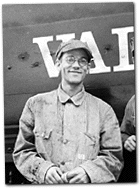 |
| Michael Stipe Photo: Jeri Arrendondo |
Filmmaker: Are there times when you prefer shooting more coverage despite the added time or expense?
Münch: When I was younger there was a tendency to want to make stuff work in a tableau, or play from the master, and I often trapped myself in terms of pacing. Though I'm very careful now about committing myself in that way, sometimes it's simply the best way to do a scene. For instance, in Color there is a shot towards the end of the movie by a riverbank in which John declares his love for Nancy, then leaves. I really wanted it to play in one, but because it was such a large chunk of film, I felt the need to protect myself. I covered it from another side angle, but in the end the scene really refused to be cut up except for the shot of Nancy at the very tail which was necessitated by a camera roll-out. It's one of my favorite scenes.
Filmmaker: Since you both write and direct your films, how does this influence the screenwriting process?
Münch: Every script is different, but the limitations of the screenplay form - which can sometimes make every descriptive line sound like every other one - are something I try to rise above by making descriptive passages as dense as possible to suggest what the movie will ultimately look and feel like, rather than simply blueprinting the dialogue. It makes for a better read, too.
Filmmaker: Your films are populated by characters whose sexuality, which is often confused or shifting, plays a vital role in his or her identity, yet at the same time, there's some ambiguity about what exactly the characters, or the films, are saying about sexual identity. How does this concept of identity originate and change as you're developing a character?
Münch: I try not to give my characters an axe to grind, try to let them be themselves, good or bad, clear or ambiguous. It's always nice to write for a particular actor or to base [a character] on someone you know, or maybe an historical figure, because it's easier to get a grasp on what the character should be doing or saying at a given moment. A character continually evolves as you work with the actor.
Filmmaker: How did you develop the relationship between John and his sister? Their relationship seems to go beyond the boundaries of sibling affection.
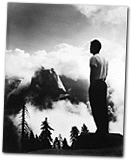 |
| Peter Alexander in Color of a Brisk and Leaping Day, photo: Rob Sweeney |
Filmmaker: What sort of preparation do you do after completing the script but before shooting begins? How much of the writing gets done during the actual shooting?
Münch: The most important preparation for me (before casting) involves visiting the places that relate to the story and absorbing some of their essence. For instance, before shooting The Hours and Times I visited many of Brian Epstein's old haunts in Liverpool and London, in an unstructured and unpressured way; many of my fondest memories of that project involve stumbling around back alleys and barrooms and docks. Preparations for Color involved endless lonely drives across deserts and mountains searching for a long-abandoned right-of-way, or a crumbling building that was once an elegant depot, or a pile of rotting equipment, or a spot that was a crossroads and now is nothing - not unlike my protagonist.
Filmmaker: Your appreciation for the landscapes and settings really comes through in the work. In Color of a Brisk and Leaping Day, you spend a good deal of time letting the environment stand on its own without any people in the frame, and in The Hours and Times there are the lyrical montages of Barcelona that seem to bookend the film. Why is environment such a preoccupation in your work?
Münch: I like to have a geographic orientation on the screen, whether it be the geography of a room or an outdoor setting. I don't like scenes that are covered in a way that fails to establish what a room looks like. The lyrical aspects of the work satisfy me most, and this aspect can embrace pictures of architecture or naturally occurring scenery, of which Yosemite is an unparalleled example. Architecture and scenery can sometimes powerfully evoke change, and the sense of loss inherent in change.
Filmmaker: Considering your films have yet to break through commercially (much less, receive wide distribution), how have you been able to continue making films?
Münch: I've been fortunate and rather stupid.
Filmmaker: How have you been stupid?
Münch: Since the time when I first began making films as a kid, I've been the recipient of a lot of plain generosity from people who have had enough faith in me to lend their expertise or contribute services or goods, even while I've been completely hopeless in actually raising money from investors. Sometimes I've been stupid in my judgement - for instance, in making The Hours and Times a medium-length work - or have not given a high enough priority to aspects of the work, usually on the craft level, that would have improved it. I've also never cultivated the skill necessary to do highly-paid work for hire, even while this lack has probably furthered my growth in other ways. You live by your own standards and your own ethics.
Filmmaker: How did you finance Color? Was it much of a departure from that of The Hours and Times?
Münch: Color had a cash budget several times that of The Hours and Times, but it was still tiny. The only reason the film got made is because of the generosity of all my collaborators and the indefatigability of Andrea Sperling, Jim Stark and Ruth Charny, our producers, without whom I would have given up long ago. We received a number of grants and many gifts. When I first wrote it I assumed I would set it up in a fairly traditional manner at a budget of around $1-1.5 million. The difficulty of casting the film with names is what ultimately led to it being done on a shoestring. I can't help but think it's a better picture because of everything it had to go through.
Filmmaker: What did you learn from making The Hours and Times that helped you realize the project?
Münch: If anything, the positive critical reaction [to The Hours and Times] gave me a false sense of thinking it would be any easier to get a film made.
Filmmaker: You've decided to self-distribute Color of a Brisk and Leaping Day. What led up to this decision? What's your strategy?
Münch: It's difficult to get a distributor to release, much less spend decent money on, a more challenging movie, and understandably so, since so many pictures of this kind perform poorly. I was sad to learn, for instance, how few people came to see The Neon Bible or Angela, to name just two amazing movies that weren't widely seen. Also, the U.S. home video market has contracted in such a way that a filmmaker can count on far less revenue from this source to offset the cost of a theatrical release. The amount of money paid by foreign distributors for American arthouse films was also more significant ten years ago. And finally, a filmmaker whose output is sparse or thematically varied is at a disadvantage compared to one whose work has a consistency of tone that helps it to attain a big following all over the world. The plans [for Color's release] are not yet final. Increasingly, though, for an American "arthouse" movie, self-distribution is the only viable option. Larger distributors who are prepared to pay an advance will only do so if all their competitors are also interested in the movie. The smaller companies may have good intentions but no cash. You can't give your movie away. With self-distribution via locked calendared runs and semi-theatrical bookings, you can at least break even on the theatrical and then realize whatever ancillary income the film can generate.
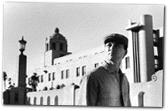 |
| Peter Alexander, photo: Brook Dillon |
Münch: The most useful designations, I think, involve simply whether a film is good or bad, whether its form is familiar or challenging, whether it has broad appeal or limited appeal - as opposed to whether it was made "independently."
Filmmaker: It seems there are more and more filmmakers in America trying to pursue their personal visions than there have been in some time.
Münch: It's true, but unfortunately, few of them are widely seen and fewer still are commercially successful. At anything but the lowest-budget level, a new filmmaker will also, understandably, tend to hedge his bets by crafting his script according to a proven model. But a first feature, like a first novel, cannot help but be charged with a powerful urgency and originality of thinking. Regrettably, these qualities all too often don't carry forward into the filmmaker's later work.
Filmmaker: Are there any individual filmmakers or films that have particularly impressed you in the last year or two?
Münch: Among the newer American filmmakers, Lodge Kerrigan (Clean, Shaven) seems to be nearly without peer. I'm very excited by Jim McKay's Girlstown and look forward to his future work. Britta Sjogren's (Jo Jo at the Gate of Lions) current project, Claire's Bones, promises to be extraordinary. Also, I really admire the work of Jem Cohen, who's done some amazing experimental work and may make a narrative feature.
Filmmaker: The Hours and Times was one of a group of films touted as the "New Queer Cinema." Do you find this term useful in either marketing or understanding films made by lesbians and gay men? What limitations, if any, do you see in the category?
Münch: What is probably most relevant about "New Queer Cinema" are the individual talents that emerged. It also helped define a commercial market for gay-themed films. It's true that The Hours and Times dealt with the friendship of two men, but what its relevance was to films that dealt with gay issues, I have no particular opinion. I would hope that the film resonates on some level outside such a limited context.
Filmmaker: What political roles, if any, do you see for the narrative filmmaker? Do any particular films exemplify your ideas on the matter?
Münch: Robert Young's Alambrista!, though not a polemic, is a powerful statement about a migrant worker's life, not to mention first-class filmmaking. Charles Burnett's Killer of Sheep similarly evokes the difficult reality of its protagonist's world. Todd Haynes' Safe is a magnificent, thought-provoking work that can't be reduced to a log-line. What I find great about Bertolucci are not his polemics, but his lyricism and humanism. As much as I admire him, Godard at his most polemical is insufferable, but at his most humanistic, transcendent. For me, a film that approaches its subject humanistically is powerful.
Filmmaker: What projects are you working on now?
Münch: At the moment I'm writing a script drawn from my family - the story of a woman at the end of her life (based on my mother) trying to reconnect with a daughter whom she had put up for adoption many years earlier.
Filmmaker: It's becoming increasingly common for one interested in making films to go to film school; you didn't. How did you get your education in film? How do you think this has distinguished you from those that did (especially those of your generation working in "independent" film)?
Münch: Making films outside of film school was the best approach for me, but it may not be for everyone. Either way, you have to "make your bad films" and somehow subdue the apparatus of filmmaking, otherwise being at the mercy of so-called experts can be your undoing. Experts will sometimes tell you that having a small or nonexistent crew equates with a certain crudeness to the work. But some of the films of Jon Jost, for example, who works almost by himself, have proven this not to be the case. Most of The Hours and Times was shot with just one crewperson, and some of it without any crew. When I was young I attended a Stanley Kubrick retrospective in which he advised the students, "The minimum crew is just one." This is true. You need someone to pull focus, unless the camera is always locked off, in which case you can do it yourself. I found a few films I liked and looked to them for inspiration and the answers to questions that arose. One way or another you have to grow up and live life before you can do your art.
VOD CALENDAR


 See the VOD Calendar →
See the VOD Calendar →

